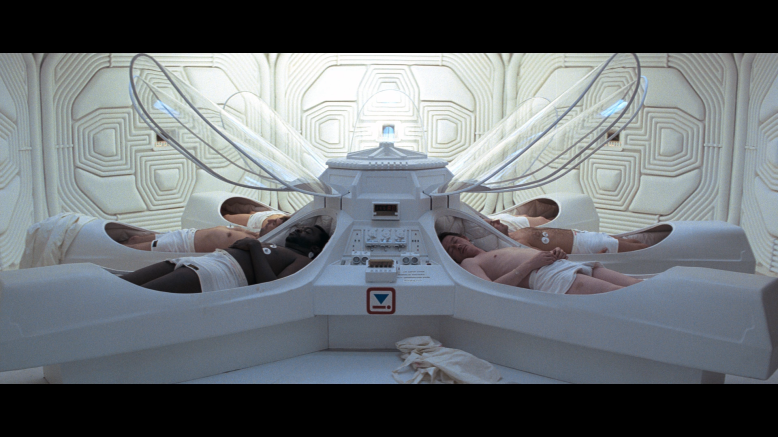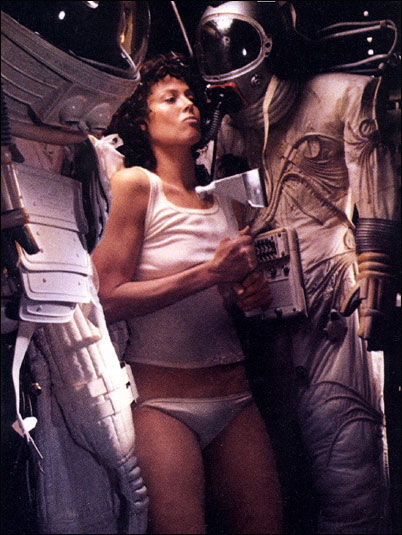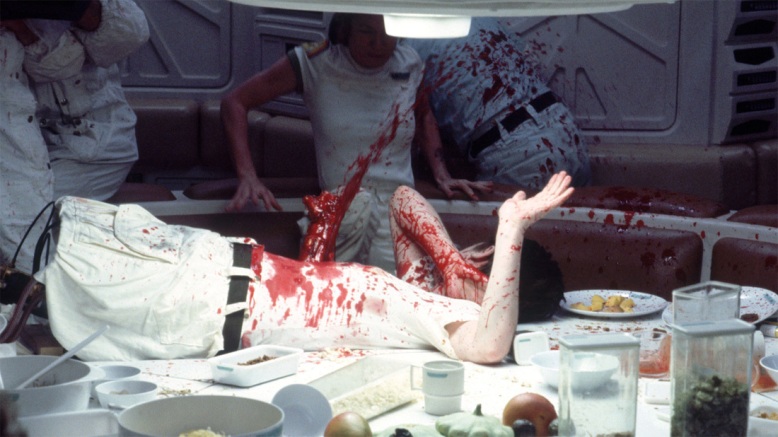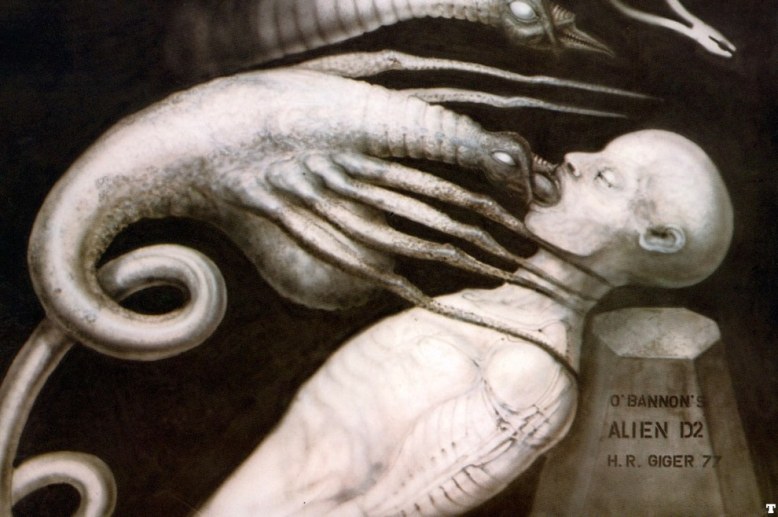A Sapphic blue “I” appears on the screen cutting through the space of the background. It looms there slicing through the science fiction conventions, the establishing shots previously seen in the Star Wars (1977, Lucas, United States) and Battlestar Galactica’s (1978 Larson, United States) of science fiction gone by. These blue markings continue to appear; the beginning of the A and the end of the N appear leaving / I \ upon the screen as we circle a Saturn like planet. Their representation of a woman’s legs, open, revealing her vagina is indicative of what is to come, “The letters… construct themselves in fractions, connoting both the growth of the organism and the tantalising visual representation of the film throughout the film.” (Flanagan, 1999) spread over 5 (soon to be 7) films (of course discounting the Alien vs Predator films), almost 2 decades and the evolution of a creature and the evolution of one woman as they span centuries, battles and procreation as sex is spat out venomously even acidically on screen as monstrous, sensuous and even as an erotic threat.

The original Alien is a strange beast, it’s aesthetic begins like something out of 2001: A Space Odyssey (1968, Kubrick, United States), the crisp white lines of the space ship’s interior reminiscent of Kubrick’s ship, echoing the destruction of his narrative, though it is not the humanity of the ship that will prove the destruction, it is the deterioration of humanity, masculinity and femininity through a hidden monster. The ship eponymously named Nostromo, brings to mind The Joseph Conrad novel of the same name, a man, Nostromo, given the responsibility of removing treasure to prevent it getting into the hands of others, ultimately corrupted by his actions and destroyed by a familial bond and his greed. The plot of which can seem to reverberating through Alien (Scott. 1979, United States) and to a further extent the whole Alien Saga. It is the name Nostromo that offers a most intriguing aspect; in Italian the name can be considered a corruption of the Italian phrase “nostro uomo”, meaning “our man”. The ship is our man, hovering in space, it/he belongs to humanity, bringing back it’s cargo to supply Earth; it/he seen as the breadwinner, that who looks after the inhabitants of Earth. Highlighted when the establishing shot pans around the underneath of the ship a large phallic mass protrudes, hanging down, but pointedly erect, thrusting forwards as the ship moves on through space, impregnating the unknown with humanity.

The film then plays with the conventions of this “masculinity”, is it the assertion that because it is a large mass of power, built sturdily and of great strength that it must be masculine? And therefore it cannot possibly be feminine? Interestingly it seems to be both: the ship or more specifically the ship’s computer is called mother, the woman who is in control, she wakes the crew from their “sleep” from the pods, only a mother can birth her children, and give them orders. “But there’s nothing more menacing than the interior of the Nostromo than a bit of industrial wear and tear.’ (ibid) The womb like pods deliver a jarring image of the womb, as they remain the solitary colour of white, sterile as a hospital room, but as far removed from the human body as it can be. The juxtaposition of the implements of life in particular human life, and humanities own designs, purports a strange vision of birth. It also jars with the other ship and its more organic interior.

Mother is the betrayer, she sends her children into this situation, answering the distress call, and birthing her children to face the consequences, as each of the ships actions is foiled by Ripley and the crew the ship a “physical environment becoming sentient” (ibid) starts to exact revenge by initiating self-destruct, which Ripley cannot counter act. Her child must destroy her, mother against daughter, as Ripley screams petulantly like a teenage girl, “you bitch, as she begins to tear down peaces of the ship and run for her life, from her own “mother”. A man, more buttoned down, the only member of the crew who wears his uniform, than the other members of the crew, the only member of the crew whose uniform resembles that of the ships interior “is he simply much more attuned to mother?” (Thompson, 1998) this connection is fully realised later in the film when it is revealed that Ash is a synthetic cyborg, attuned to “mother” because “mother” tuned him. He is under strict orders to investigate the planet and bring back one of the aliens, as biological warfare. But his characteristics label him as a mummies boy, under strict orders, under the apron strings and a completely asexual being, he shows no yearning to any of the female characters, or for that matter any of the male characters; his stoicism in the film makes his actions far more sinister, machines cannot be human, and therefore he is as much an alien as an creature that comes aboard. Interestingly it is the only perceived sexual threat that comes in Ash, once the alien is aboard the ship creating chaos, Ash begins to malfunction, his rolled up magazine being forced down the throat of Ripley is an impotent man enforcing rape, an act he simply cannot achieve, not being human, terror on his face as he then clutches the breast the male Parker, making him writhe in pain. The only seemingly sexual form of interaction between members of the crew comes from a synthetic human, someone incapable of having sex.

The characteristics of the crew all seems fairly androgynous, “in O’Brannan’s first script the crew members had been written in such a way that they might be men or women” (ibid). In terms of plot development the parthanogenic birth of these characters isolates their sexuality and gender being birthed, it is only through the plot do roles of identity begin to emerge, the hysterical woman, Lambert constantly screams hysterically in displays of stereotyped action defining female agency, Dallas constantly affirms his authority as captain in a display of male agency. It his Ripley who is the exception to the rules of character development through gender specification, she is the only crew member who obeys all rules set out to her, she refuses to let the creature aboard and does not conform to the screaming stereotype, she asserts power, by berating Ash, she asserts her power, opposing the female stereotype yet retaining femininity, she holds power second only to Dallas, and only as the film comes to it’s frantic conclusion we become aware of Ripley as a sexual being stripped to her small underwear she stands as an object of the male gaze having become an antithesis of it. It is a jarring moment, but a moment that defines Ripley for a generation; she retains her femininity, holding the look upon her, yet she retains her authority, she alone destroys the hulking mother ship, survives where all other masculine men couldn’t and most importantly she survives that monster, its sexually designed phallic destructiveness hasn’t penetrated her, for all intents and purposes she is the virginal heroine of the horror genre gone by, marks her as an example of the staple of horror typology referred to …as the ‘final girl’” (Flanagan, 1999)

H.R. Giger’s designs very much encapsulate the creature’s design; it extends what we have already seen of the environment through which we initially encountered it. “enter[ing] the body of the unknown space-ship through a ‘vaginal’ opening: the ship is shaped like a horseshoe, its curved sides like two long legs spread apart at the entrance.” Giger’s design of the ship encapsulates the organic feel of the origins, the ship made form bones, feels as if it has lived itself, it sits stately looking at its surroundings it, makes noises when it is disturbed, but it is it’s oozing, grotesque deformation of human’s sexuality and sexual organs which perpetuates what is to be a withstanding image, that will evolve through out each movie. As it stands there its “legs” spread, awaiting penetration, it is entered by Kane, this is where conventional “human” copulation differs, by disturbing a nest Kane is attacked by the face hugger, a animalistic embodiment of the vagina wrapping itself around the face of the man, the act of cunnilingus becomes asphyxiation.

He then is penetrated by this vagina in his chest, and is left a secondary creature to gestate and become humanoid in shape, it is the inversion of human sex act “horrifying confusion of the sexual-gynecological with the gastrointestinal is pitched onto life-death, male-female” (Kavanagh, 1990). Kane is then punished in a gruesome way, the alien bursts through his chest in a repugnant play on childbirth, and the creature phallically designed by Giger who “was obsessive, very sexual in most of his work and an eager student of nightmare.” (Thompson, 1998). It rips through his chest a toothed penis the threat of being penetrated by a man reversed as it is inside him, trying to escape, perhaps purporting that homosexuality is a monstrous trait inside all men. It grows to become a threat whose mouth’s emerge from inside one another pressing forth, especially in the climactic showdown, Ripley finally feminized, in her underwear, her sexual body on show, she is almost caressed by the creature as it lunges forth at her.

It is when Ripley has been viewed as the sexual being that she is able to destroy the abhorrent alien, and re-enter the pod, “motherless”, and preserved as sleeping beauty amongst the ethereal light and the comfort of the only other living survivor Jones, the cat.

